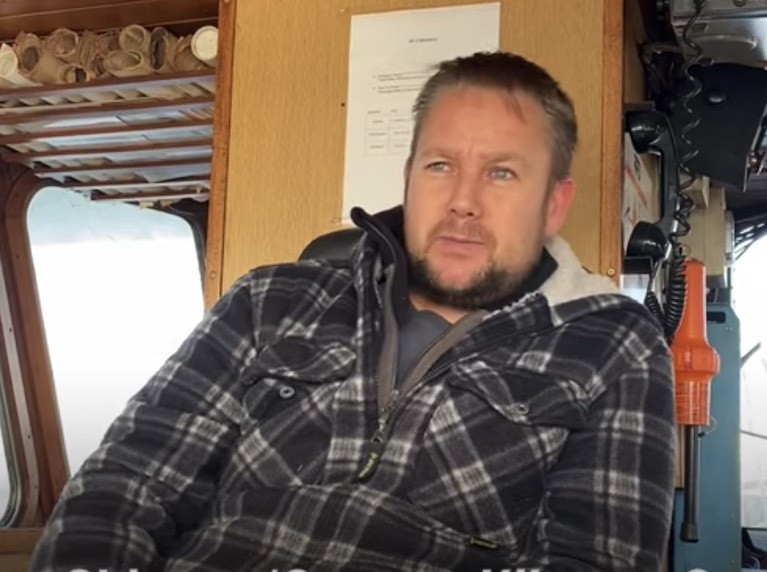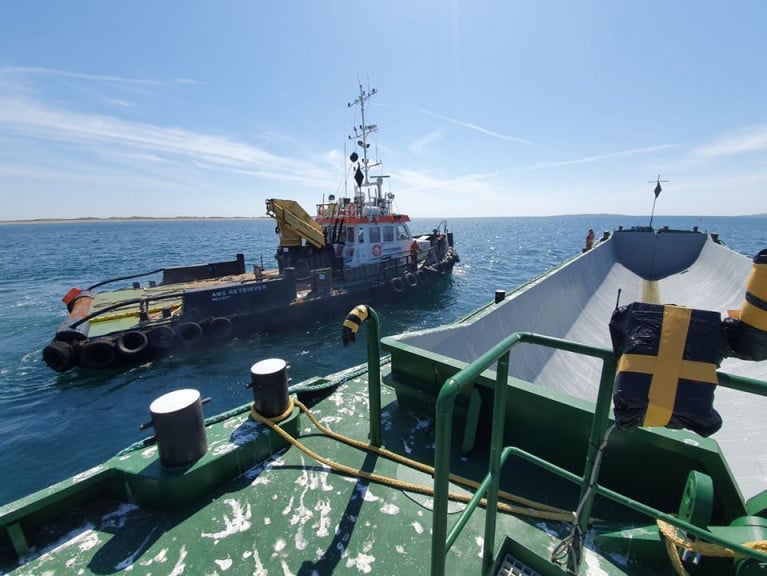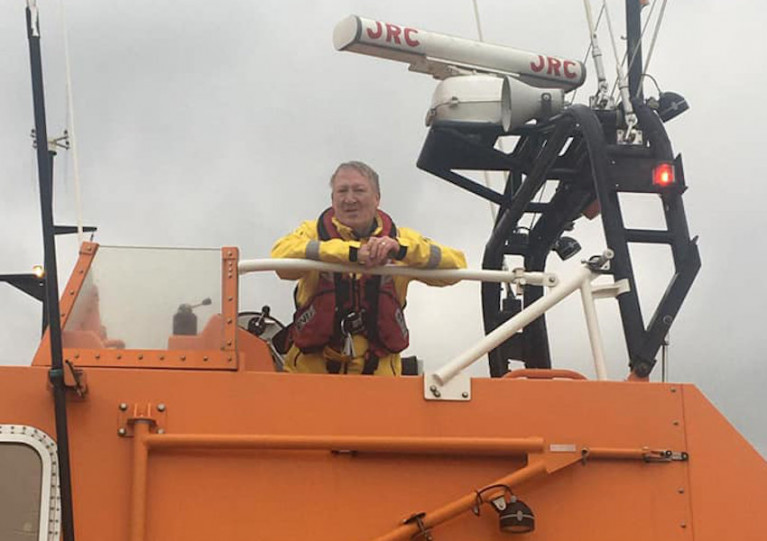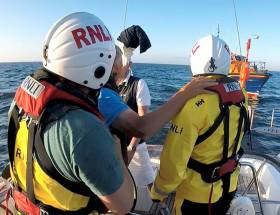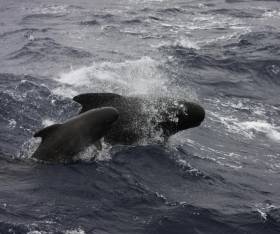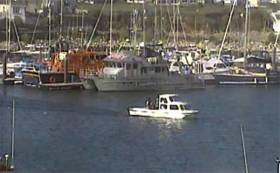Displaying items by tag: Kilmore Quay
Kilmore Quay RNLI rescued four people early this morning (Thursday 12 August) after their yacht got into difficulty and subsequently sank 50 miles off the Wexford coast.
The volunteer crew were requested to launch their all-weather Tamar class lifeboat Killarney at 2.44am to attend to the 14m yacht which had sustained a damaged rudder 50 miles south of Kilmore Quay while on passage from Dublin to Vigo in Spain.
Under coxswain Eugene Kehoe and with four crew onboard, the lifeboat immediately launched and made its way to the scene. They were updated on the way that the yacht’s crew had made the decision to turn back and slowly make their way to Kilmore Quay.
Arriving at the location at 5.30am, the lifeboat crew checked that all onboard the yacht were safe and well before assessing its situation. It was decided to set up a towline and return the vessel to the nearest port which was Kilmore Quay.
As the yacht began to take on water, the lifeboat crew placed a salvage pump on the vessel. But such was the speed at which the vessel was taking on water, it was not enough to deal with the situation.
A second salvage pump was requested by the Irish Coast Guard helicopter from Waterford, Rescue 117, which was also tasked to the scene.
However, it was decided at this stage to remove the four people from the yacht and transfer them safely onto Kilmore Quay RNLI’s lifeboat. The yacht subsequently sank.
The lifeboat brought the four casualties safely back to Kilmore Quay where they arrived at around 11am.
Speaking following the call out, Kilmore Quay RNLI’s lifeboat operations manager John Grace said: “It is always sad when a vessel is lost at sea but thankfully the crew onboard the yacht was safely rescued and are now back on shore.
“The casualties did the right thing in raising the alarm when they encountered problems in the early hours of this morning which helped to prevent the situation from becoming much worse.
“Despite the best efforts of everyone on scene, the vessel took on a lot of water. Our priority then was to ensure that the casualties were taken off the yacht and transferred safely on to the lifeboat.
“We would like to wish the casualties well following their ordeal this morning and we would like to commend our volunteers who despite the early call and darkness of night, did not hesitate to respond.”
The lifeboat crew involved in this callout were coxswain Eugene Kehoe, mechanic Philip Walsh and crew members Aidan Bates, Sean Furlong and Nigel Kehoe.
The RNLI is to present three Irish lifeboat crews with gallantry awards for their role in a rescue last October that saved nine lives and prevented a 100m cargo vessel from hitting rocks at Hook Head.
The coxswains of Dunmore East RNLI, Kilmore Quay RNLI and Rosslare Harbour RNLI are to receive RNLI Bronze Medals for Gallantry — one of the highest awards presented by the lifesaving charity — while the volunteer lifeboat crews who responded to the callout will each receive Medal Certificates.
Recognition will also be given to the crew of the Irish Coast Guard’s Waterford-based helicopter Rescue 117, the staff of the National Maritime Operations Centre in Dublin and the master and crew of the tug Tramontine.
As previously reported on Afloat.ie, the multi-agency rescue operation was launched on 20 October 2020 after reports that the Lily B — a 4,000-tonne cargo vessel carrying 4,000 tonnes of coal — had lost all power and was in danger of hitting rocks south of Hook Head in Wexford.
Battling strong waves over six metres high amid Force 8 conditions, the Dunmore East and Kilmore Quay lifeboats managed to establish tow lines onto the drifting vessel and, with the help of the Rosslare Harbour crew, worked together to ensure the vessel stayed away from the rocky shore until the tug arrived.
RNLI director of lifesaving John Payne said: “Those crews involved demonstrated that unique blend of courage, selflessness, dependability and trustworthiness, at their best, in the most demanding of conditions. Without question their combined actions saved lives at sea.
“Conditions onboard the lifeboats were unpleasant in the rolling and pitching seas. The volunteer crews displayed fortitude, perseverance and courage to remain focused whilst under the most testing conditions, often up to their knees in water and heaving decks.
“The unity of purpose and sense of ‘One Crew’ displayed by all contributed significantly to the successful outcome in a protracted 12-hour service.”
 The three coxswains (from left), Roy Abrahamsson of Dunmore East, Eugene Kehoe of Kilmore Quay and Rosslare Harbour’s Eamon O’Rourke | Credit: RNLI
The three coxswains (from left), Roy Abrahamsson of Dunmore East, Eugene Kehoe of Kilmore Quay and Rosslare Harbour’s Eamon O’Rourke | Credit: RNLI
The three coxswains — Roy Abrahamsson of Dunmore East, Eugene Kehoe of Kilmore Quay and Rosslare Harbour’s Eamon O’Rourke — were informed of the awards by RNLI area lifesaving manager Joe Moore, who said: “In recommending these awards, the RNLI Trustees recognise the difficulty of the service, the challenges that were faced by the lifeboat crews during their 12 hours at sea and the tragedy and environmental disaster that was averted off the Irish coast.”
In reviewing the service, the RNLI also recommended a Medal Service Certificate for the crew of Irish Coast Guard helicopter Rescue 117 for their top cover and reassurance to all the crews below for the duration of the service.
Signed letters of appreciation will also be presented to the staff of the National Maritime Operations Centre in Dublin and the master and crew of the tug Tramontine.
Details of the arrangements for the presentation of Bronze Medals for Gallantry and the Medal Service Certificates are to be arranged in consultation with the awardees.
List of lifeboat crew to be honoured by station:
- Dunmore East RNLI crew: Roy Abrahamsson (Coxswain), David Murray (Mechanic), Neville Murphy (Navigator) and crewmembers Peter Curran, Jon Walsh, Luka Sweeney and Kevin Dingley.
- Kilmore Quay RNLI crew: Eugene Kehoe (Coxswain), Philip Walsh (Mechanic), Aidan Bates (Navigator) and crewmembers Trevor Devereux and Sam Nunn.
- Rosslare Harbour RNLI crew: Eamon O’Rourke (Coxswain), Mick Nicholas (Mechanic), Keith Miller (Navigator) crewmembers Padraig Quirke, Michael Sinnott, Eoghan Quirke and Paul McCormack.
Brexit Impact on Irish Fishing Industry Requires Dedicated Marine Minister
As details emerge on the full negative impact of Brexit on the Irish fishing industry, two Wexford skippers have called for the appointment of a dedicated minister for marine.
Scallop skippers Will Bates and Seamus Molloy who fish from Kilmore Quay have welcomed Taoiseach Micheál Martin’s appeal for “progressive ideas” from the fishing industry.
However, they have said the government must have a Cabinet member whose sole task is to provide leadership in relation to the difficulties facing the Irish marine sector.
 Seamus Molloy - Kilmore Quay Scallop fisherman. Screenshot: Sean Moroney
Seamus Molloy - Kilmore Quay Scallop fisherman. Screenshot: Sean Moroney
Ireland must start “taking back”, given that it will represent some 12 per cent of EU waters – but with “30 per cent of fishable waters”, the fishermen have said.
"Ireland should seek a share of the bluefin tuna quotas allocated to other EU member states"
As a first step, Ireland should seek a share of the bluefin tuna quotas allocated to other EU member states, given that the migratory fish spend up to four months off this coast, they say.
Under the Brexit deal finalised on Christmas Eve, the EU is handing back 25 per cent of its share of the catch in British waters.
There will be a five-and-a-half-year transition period, after which both sides will hold annual negotiations on some 100 shared stocks from 2026.
Seán O'Donoghue, chief executive of the Killybegs Fishermen’s Organisation (KFO), said the deal demonstrated the “duplicitous nature of the protracted negotiations” and that the “repeated guarantees” given to Irish fishermen had effectively been shredded.
The four and a half years of agreements have for all intent and purposes been “dishonoured by the negotiators” the KFO leader has said.
The reaction of the Kilmore Quay skippers can be heard on Wavelengths below
Tug And Barge Project to Dredge Wexford's Kilmore Quay - Origin to Former Ferry Operator to France
A Wicklow Port based tug has completed a six day towage operation from Rotterdam, The Netherlands when it arrived off the coast of Kilmore Quay in Co. Wexford yesterday afternoon, writes Jehan Ashmore.
The 18.5 tonnes bollard pull AMS Retriever operated by Alpha Marine, the tug and workboat marine services company, deployed the Dutch shipyard built Damen Shoalbuster 2409 series tug to tow the split hopper-dredger barge B302.
It would appear the tug has at least served under two previous names, Marineco Akela with Leith in Scotland as the port of registry and as the C M Kurok when working in the Caspian Sea.
Both the Belfast registered tug and the Dutch barge will be assigned to work with Marine Specialists Ltd on the dredging of the south Wexford coast harbour which is to take place throughout this month. The shallow draft tug which has a crew of 5 will prove ideal option for such near coastal works.
Kilmore Quay is homeport to a fishing fleet and a 60-berth marina. In addition, the location over the years has been popular for leisure users, angling-hire craft and ferry boat trips out and to the nearby Saltees Islands.
As Afloat previously reported Alpha Marine's other tug, Husky was deployed last year to the former Stena Line ferryport at Dun Laoghaire Harbour having towed a barge laden with granite from Cornwall. This project was to replenish rock armour following Storm Emma of 2018 that mostly inflicted the East Pier and the project also involved use of a landing craft to convey heavy machinery by sea due to access issues.
Returning to the sunny south-east, where the O'Flaherty family has major fishing operations in the Wexford harbour which is homeport to their fleet of 10 beam white fish trawlers. They also have 3 twin riggers for prawns and a pelagic vessel. In addition to their fish wholesaler business, Saltees Fish has a cold storage plant located at the harbour.
Notably, the O'Flaherty's established Celtic Link Ferries in 2005, having acquired P&O Ferries Rosslare-Cherbourg route which they withdrew operations the previous year. In the deal, this included the route's ro-ro freight ferry European Diplomat (1978/16,776grt) with space for some 80 truck units and around the same capacity for passengers. This enabled the O'Flaherty's maintain their vital fishing exports to markets in mainland Europe.
CLF continued the business of providing freight hauliers on the Ireland-France link where truck drivers (including those for liverstock) were also part of the trade. Truck drivers on board the renamed Diplomat also shared dining facilities with a limited capacity of (motorist-only) passengers. This combination made the ferry operation unique on Ireland-France routes, with exception of Seatruck Ferries on their route network across the Irish Sea.
Celtic Link also had competitive rates for holidaymakers based on a 'no frills' basis compared to the more established ferry rivals, Irish Ferries and Brittany Ferries though they also have their 'économie' services soon to be operating from Rosslare this month.
When making a trip in 2009 as a guest of CLF, and notably as an exception having travelling as a 'foot' passenger which provided an opportunity to observe.On that related note the aft observation lounge however was not open on that particular crossing (see Ships Monthly, Nov.2009). This feature otherwise afforded excellent views was located at the highest passenger deck of the ship's superstructure and aft over the stern.
In addition on board was a plaque dedicated to then named Baltic Ferry, which served in the Falkland's Task Force in 1982 where the war involved RAF Harrier Jump-jets (VTOL) aircraft use the freight-ferry.
Unlike conventional ferries, Diplomat like many ro-ro freight ferries had the superstructure all located aft, with the uppermost vehicle deck exposed on the weather deck ahead of the bridge. The ship was built originally for Stena as one of their successful 'Searunner' series built in South Korea and for their charter market which saw these ships deployed worldwide on deep-sea routes.
After CLF ended its Irish career of Diplomat they chartered the ro-ro to the Carribbean. Replacement tonnage saw a succession of two Visentini-built passenger ropax's, Norman Voyager (of LD Lines short-lived Rosslare-Le Havre run) and Celtic Horizon (Ships Monthly, Feb.2013) which was renamed as outlined below.
CLF's (farewell) operations proved tempting as Stena Line made a bid to take over the Ireland-France route, which in 2014 became the company's first ever such direct route connecting mainland Europe. This saw the ropax renamed Stena Horizon and compete with the then presence of Irish Ferries running to Cherbourg in addition the summer-only Roscoff service (see, yesterday's story: Rosslare's Manager Says Europort can Take One Fifth of Dublin Port Activity).
It was at the 'Europort' in 2005, the first year of CLF operations, when a fleet of scallop trawlers based from Kilmore Quay held a fisheries related protest at the Wexford ferryport. The blockade prevented all ferries of the port, though when they departed the 'unaffected' Diplomat arrived afterwards.
As for Irish Ferries cruiseferry Isle of Inishmore, this ferry was less fortunate as not only was it subject to the blockade at the Irish ferryport but had the misfortune for a second time in the same year to be embroiled in a strike and siege incident (albeit in Pembroke Dock). On that occasion the ferry was centre-stage in the protracted and bitter Irish Ferries dispute over the replacement of Irish crew with lower-cost personnel from overeas.
Kilmore Quay RNLI’s Station Mechanic Retires After 50 Years’ Service
Brian Kehoe, station mechanic at Kilmore Quay RNLI, has retired from his position as full-time station mechanic and coxswain after serving over 50 years with the RNLI, half as a volunteer and half as an employee.
Brian went afloat for his last exercise on Tuesday (31 December) as station mechanic. He was joined by crew from the flanking lifeboat stations of Rosslare Harbour, Fethard-on-Sea and Dunmore East.
Kilmore Quay Coast Guard was also on hand while the Irish Coast Guard helicopter Rescue 117 joined the exercise and Brian was winched from the lifeboat onboard the search and rescue aircraft.
Back ashore after the exercise, Brian’s family gathered at the harbour for some photos and the people of the village came to wish him a happy retirement.
An official night to mark Brian’s retirement will take place at Coast Hotel Kilmore Quay on Saturday 25 January, and all are welcome to attend. Everyone at Kilmore Quay Lifeboat Station wishes Brian and his wife Theresa a long and healthy retirement.
A man was taken to hospital with hand injuries by Irish Coast Guard helicopter after a Mayday call on a yacht off Kilmore Quay on Saturday (29 June).
The local RNLI lifeboat crew were en route to another vessel that had requested a tow when the call came in from a 12m yacht some 13 miles south-west of the Co Wexford village.
It was reported that as the yacht’s crew were adjusting a sail, a piece of rigging had parted and seriously injured the skipper’s hand.
The lifeboat arrived just after the Waterford-based coastguard helicopter Rescue 117, whose crew determined the best course of action was to transfer the casualty to the lifeboat for pain relief.
He was subsequently winched to the helicopter and flown to Waterford University Hospital for further treatment.
It was a busy weekend for RNLI lifeboats in Arklow, Larne and Kilmore Quay which each had callouts over the Easter period.
Arklow RNLI launched on Sunday afternoon (21 April) to assist a jetski in difficulty following a launch request from the Irish Coast Guard at 3.15pm.
The volunteer lifeboat crew left their families on Easter Sunday to answer the callout, bringing the all-weather lifeboat Ger Tigchlearr just north of Arklow Harbour where the casualty vessel had been reported adrift and without power.
The jetski, with two people aboard, was quickly located off the back of Arklow's North Pier, dangerously close to the rocky shoreline.
The two people aboard were immediately recovered onto the lifeboat and a line was secured to the jetski to tow it back to shore.
In Larne, RNLI volunteers were called out twice on Sunday evening to people in difficulty.
In the first callout, both the all-weather and inshore lifeboats were called to aid two kayakers who had overturned near Browns Bay just off Islandmagee.
Larne RNLI launched into a calm sea at 5,45pm with the inshore lifeboat, Terry, tasked to bring the kayakers safely to shore, while the all-weather lifeboat Dr John McSparran was tasked to recover the kayaks left behind.
After a successful recovery of both casualties and their equipment, Larne RNLI helm Pamela Leitch noted: “The two kayakers were wearing buoyancy aids; they also remembered to stay with their kayaks which made it easier for us to identify them and bring them ashore.”
The second callout involved the all-weather lifeboat towing a 26ft sailing boat which had run aground at the East Maidens lighthouse.
One of the two people onboard had asked to dock close to the Maidens so they could have a look around. However, while they were the docked the tide ebbed and the boat was left on rocks.
The remaining crew member was able to use their VHF radio to call for assistance from Belfast Coastguard, who requested the launch of the all-weather lifeboat.
When Larne’s volunteers reached the boat, they found that it had moved off the rocks and that no damage had occurred to the hull.
However, it was suggested that the casualty boat follow the all-weather lifeboat into Larne to assess any further damage.
As both boats were making their way into the Port of Larne, a tow line was established as the casualty vessel was experiencing some engine troubles. The vessel was then towed to a mooring at East Antrim Boat Club.
Meanwhile, in Kilmore Quay, the local RNLI lifeboat was alerted by Dublin Coast Guard at 5.25pm that an 11m boat with two people on board had lost engine power three-and-a-half miles south of Bag-N-Bun Head to the west of Kilmore Quay.
Conditions were near calm at the time with restricted visibility due to coastal fog. Visibility was down to one tenth of a mile at times.
The volunteer crew made best speed towards the casualty vessel, arriving alongside twenty minutes later. A tow line was passed over and the vessel was towed back to Kilmore Quay, which took just under an hour to complete.
The four Easter Sunday callouts came after Saturday launches for Courtmasherry RNLI, to a Spanish-bound yacht in distress, and Carrybridge RNLI, to two boats in difficulty on Upper Lough Erne.
“Given the fantastic weather we’ve had this weekend, we’ve seen higher numbers of people coming back to the beaches and putting their boats and other craft back in the water, earlier than usual,” said Mark Corcoran, community safety officer at Arklow RNLI.
“We’d like to remind people to always respect the water, wear a lifejacket and carry a means of calling for help when going out on the water.”
Wexford Men Come To Rescue Of Beached Pilot Whale
#MarineWildlife - A young pilot whale was saved by a group of quick-thinking Wexford men after stranding on a beach at Kilmore Quay, as the New Ross Standard reports.
When Neil Bates spotted the 3m whale at Ballyteige Burrow and saw its blowhole move, he enlisted two other local men, John and Michael O'Flahery, to help refloat the animal.
And while it was it some distress for a time, it was soon out of the shallows and swimming in the direction of Hook Head.
In other marine wildlife news, the Irish Whale and Dolphin Group is seeking to recruit a new general manager, based out of the Shannon Dolphin Centre in Kilrush, Co Clare.
Kilmore Quay Literary Festival Attracts Wexford Literary Scene
Billy Roche, Cat Hogan and Paul O’Brien are among an impressive list of Wexford literary names already confirmed for the inaugural Write By The Sea, a festival of writing and reading set to take place in Kilmore Quay, Co Wexford from September 23 to September 25, 2016.
A packed schedule of workshops, readings, conversations and interviews will also feature such established local writers as A.M. Cousins, Margaret Galvin, Jackie Hayden, Margaret Hawkins, Daithi Kavanagh, Jim Maguire, Peter Murphy and Fiona O'Rourke.
Billy Roche will read from his writings as well as delivering a workshop on Playwriting. Margaret Hawkins will talk about Journalism, and Paul O’Brien will be interviewed on-stage about his best-selling trilogy of novels Blood Red Turns Dollar Green.
A.M. Cousins will direct a workshop on writing for radio, Margaret Galvin’s workshop will focus on participants’ personal memories and stories , and Jackie Hayden will talk about how he discovered the Welsh poet Dylan Thomas through The Beatles and Bob Dylan.
Cat Hogan will discuss what writers need to do after they’ve completed a new work, and she’ll also talk about her acclaimed debut novel They All Fall Down. Novelist and spoken word performer Peter Murphy is scheduled to read from his works, as well as offering invaluable advice for aspiring writers. Daithi Kavanagh will explore the world of e-books, Jim Maguire will hold a workshop on “the journey home’ and Fiona O’Rourke will explore ways of kick-starting your writing creativity.
#MCIB - The lack of a handheld VHF radio or float-free EPIRB potentially delayed the rescue of passengers from a capsized vessel off the Saltee Islands last August.
One man died by drowning but nine others were rescued after a five-hour ordeal at sea when their leisure craft was swamped in the channel between the islands, as previously reported on Afloat.ie.
According to the official report on the incident by the Marine Casualty Investigation Board (MCIB), the 21ft Dory named 'Jillian' was already low in the water when it set out from Kilmore Quay in Co Wexford on the afternoon of Saturday 29 August 2015 with its owner-skipper and nine passengers on board.
Shortly before 7pm, as the boat passed through the channel in what are commonly choppy waters towards fishing grounds south of Great Saltee, witness reports said that a wall of water came over the bow, forcing through the acrylic glass windows of the wheelhouse and flooding the cabin.
Before efforts could be made to bail out the boat or use the fixed VHF radio in the wheelhouse, the engine stopped and more water flooded in, causing the vessel to capsize quickly.
One passenger was trapped under the hull but was rescued moments later by one of the others, and all but one managed to climb onto the upturned hull.
With no handheld radio or EPIRB on the boat, the skipper and his passengers were unable to call for help. A flare found by one of the survivors was discarded as none knew how to operate it and feared injury in doing so.
Many hours later at midnight, as the group were having difficulty staying on the upturned hull, they attracted the attention of the Saltee Islands ferry which had joined the search party with the Kilmore Quay and Fethard RNLI and the Irish Coast Guard minutes before.
Within 20 minutes all 10 casualties had been taken aboard the ferry, but one was quickly transferred to the Kilmore Quay lifeboat when his health appeared to be failing.
Despite the swift actions of the lifeboat crew and the personnel of coastguard helicopter Rescue 117 who continued CPR, the man was pronounced dead on arrival at Wexford General Hospital.
The investigation later determined that the skipper did not know the maximum load capacity of his vessel, though it was built before such information was made mandatory for the maker's name plate.
It was therefore judged likely that the additional passenger weight caused the boat to sit low in the water, making it vulnerable to breaking waves in the rougher waters between the Saltees.
In addition, if the boat had carried a handheld radio or EPIRB, or had anyone on board knowledge of how to use a flare, it's likely that the party could have been rescued earlier, the report concluded.
The complete MCIB report into the 'Jillian' incident is available to read or download HERE.


























